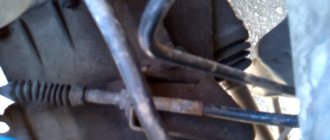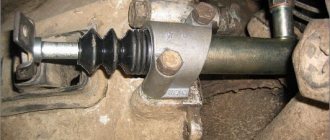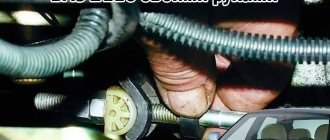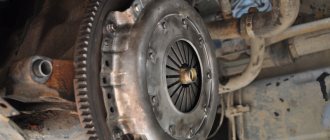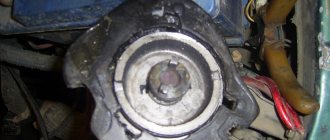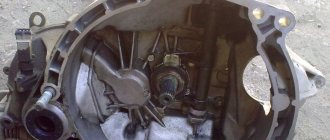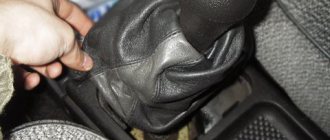Modern domestically produced cars have moved away from the classics. Standard clutch adjustment of the VAZ 2114 and other vehicles of the family is performed by tightening the cable rather than by adjusting the hydraulic mechanism, which increases the reliability of the unit. This mechanism requires periodic adjustment - the steel cable tends to stretch under load, which disrupts the original characteristics.
The drive must be tightened in such cases.
- Violation of the accuracy of gear shifting - squeaks, crackles or other extraneous sounds emanating during manipulations with the gearbox.
- There is a dissonance between the increase in engine speed and the acceleration of the car. This is a clear sign that the clutch disc is slipping under load. A secondary symptom is a burning smell after sudden acceleration or dynamic acceleration.
- The pedal fails or spontaneously rises or falls relative to the reference value.
- The clutch engages early or late, which leads to the car jerking while shifting into gear.
How to adjust the clutch cable
Very often similar entries come up - I installed a new clutch cable, the clutch stopped working.
And it's all about the simplest adjustment of the clutch cable. To begin, before installation, tighten the clutch cable tensioner located on the clutch release lever until it ends. This way you can, firstly, easily install a new cable, and secondly, continue the adjustment.
Next, insert the cable into the mounting eye, which is most often screwed to the right engine cover. To tension the cable, adjust in the direction the arrow is pointing.
In this way we tighten until the cable receives a slight tension! SMALL. THERE IS NO NEED TO STRETCH IT LIKE A STRING!
Final adjustment can be completed with the lower cable tensioner located on the motor.
But for a beginner, it is better to slightly tension the cable first with the lower tensioner, and make the final adjustment with the tensioner, which is located on the clutch release lever. It’s easy to adjust on the steering wheel: turn the tensioner out and tighten it. We wrap the tensioner and tighten the cable.
The cable tension must be such that there is free play on the lever! Approximately 2-3 mm. That is, when you touch the lever with your finger, it should move closer to you without effort, by about 2-3 mm.
In this case, when you release the lever, it should return to its original position.
Why, exactly, is this free movement needed?
And this is simple physics. When heated, the metal expands, including the entire clutch assembly, which leads to a decrease in clearances. And if your cable is too tight, then when the engine is hot, the clutch will slip, and the clutch discs will simply burn out, because they will not be in full contact with each other, but will constantly slip through.
Bottom line: adjusting the clutch is extremely easy! And it is the correct adjustment that will extend the life of your gearbox and clutch as a whole.
Source
Diagnosis of clutch faults
You can check that the clutch is working properly like this.
- Put the car on the handbrake.
- Move the gearshift lever to the neutral position.
- Start the engine.
- Engage the gear and slowly release the clutch.
As a result, the car should stall. If this does not happen, the clutch needs to be adjusted.
How to adjust the clutch cable
The main task of the clutch is to temporarily separate (uncouple) the engine and transmission and smoothly connect them. These operations are necessary while driving to control a manual transmission: shifting gears, stopping, braking, starting the car.
If the adjustment of the free play of the clutch pedal is disrupted, the car stops moving normally, various problems arise - it becomes impossible to move away, gears are switched with a crunch, and the car may also slip and accelerate poorly.
How to adjust the clutch. General leadership
Checking the clutch cable clearance . Depending on the make of the car, the cable play on a mechanical clutch can be checked and adjusted in different ways.
There are three main ways:
- changing cable length when the clutch lever is operating;
- measuring the distance between the adjusting nut and the fork;
- measuring the distance between the adjusting nut and the cable stopper.
Some vehicles can use either of these methods. But the measurement must be carried out between the points given in the car manual or in the operating instructions.
Checking and adjusting the clutch fork . The vehicle must be securely raised on ramps or stands. We also use the handbrake to lock the wheels.
- We find the clutch cable coming down from the clutch pedal and protruding through the clutch control lever. There are threaded bushings with two nuts that are located on the protruding end of the cable.
- The clearance has a difference between the measurement when the shift lever is at rest and when it is in the inward position.
- To measure it, hold a ruler near the cable between the control lever and another reference point, such as the edge of the clutch housing.
- Gently press the lever all the way, align the ruler with its end and measure the distance between the lever and the reference point.
- Pull the lever outward and measure the distance again. We find the difference between the two measurements and compare it with the specified data from the manufacturer.
- If the gap needs to be adjusted, loosen the union nut on the threaded bushing, which is popularly called a lock nut (on some VW cars this is a wing nut).
- Next, turn the adjusting nut forward or backward to decrease or increase the gap, checking the measurement as necessary.
- Tighten the locknut and press the clutch pedal several times. Check the gap again and adjust if necessary.
On some vehicles with underbody protection, it can be very difficult to reach the locknut and turn it if necessary. In this case, you will need a special wrench that has a socket and a universal disk to perform this procedure.
Gap measurement . We measure the distance between the operating lever clutch and a reference point, such as the edge of the clutch housing. The first operation is carried out with the control lever at rest, and then when it is in the pressed position. The difference between these two measurements is the amount of free play of the lever on the cable. This is the gap in the clutch cable.
Another way to check and adjust . We find the place where the clutch cable protrudes beyond the fork and the nuts on the threaded bushing.
- Use pliers to unhook the release spring from the clutch fork.
- We take the threaded end of the cable (if necessary, you can take pliers) and tighten it to the possible level, which will allow you to raise the clutch pedal to the limit.
- You can measure the distance between the adjusting nut and the inner edge of the clutch fork coupling with a ruler. This is the clearance measurement.
- We compare the data obtained with the figure specified in the vehicle’s operating instructions.
- If there is a need for adjustment, this can be done as described above.
Checking and adjusting the clutch cable . This method is used on some older cars.
- In the fully raised position, use a block of wood to jam the clutch pedal.
- Having found the location of the clutch cable, we find where the outer cable is pressed against the edge of the housing.
- The locknut and adjustment nut are located at the end of the cable, next to the retaining bracket.
- Hold the outer part of the cable and pull it back until it stops, which will expose the inner cable.
- Using a ruler, measure the length of the exposed part of the cable between the end of the cable and the adjusting nut. This is the clutch cable clearance measurement.
- We compare the obtained data with the data specified by the manufacturer and, if necessary, adjust.
- Loosen the lock nut and turn the adjusting nut either back or forward to obtain the optimal value.
- Tighten the locknut and measure again.
Checking and adjusting the hydraulic clutch . Many hydraulic couplings are self-adjusting, but some designs allow manual adjustment to compensate for friction plate wear.
- If the fluid coupling is adjustable, the pushrod on the slave cylinder will be threaded and equipped with a lock nut.
- We lift the car securely onto the ramp or axle stands.
- We climb under the car and find the clutch slave cylinder and its adjustable pusher.
- Use pliers to unhook the release spring from the fork. Push the clutch fork forward until it stops.
- Holding it in this position, use a ruler to measure the distance between the end of the working cylinder body and the clutch fork.
- We release the fork, and then measure the distance again while it is at rest.
- The difference between these two measurements is the clutch clearance. We compare this with the number given in the car manual and adjust it if necessary.
- The locknut and adjusting nut are located on the threaded end of the pusher. Loosen the locknut.
- We turn the adjusting nut screw towards the working cylinder to increase the clearance, or towards the clutch fork to reduce it. When the measurement is correct, tighten the locknut.
- We check it again and, if necessary, adjust it again.
Work progress
- ruler.
- Place a ruler next to the clutch pedal pad, resting it perpendicularly to the mat. Using a ruler, visually determine the distance from the mat to the rubber pedal pad. If it is more than 16 cm, then it is necessary to adjust the clutch cable.
Now open the hood and use the first key (in the figure it is marked “B”) to loosen the locknut on the cable tip. Then, turning the adjusting nut with a second wrench to 13 (“A”), we set the full pedal travel to 12-13 centimeters. When screwing the nut onto the tip, the full stroke increases, and when unscrewing, it decreases.
Source
How to adjust the clutch on a VAZ 2108, 2109, 2199
1). When the pedal is released, you need to use a tape measure to measure the distance from the floor to its lower edge. It should be within 18-20 centimeters.
2). Next, press the pedal with your hand all the way to the stop and measure the distance from the floor, again to the bottom edge. It should be within 6-7 centimeters.
3). From the first result obtained, 18-20 cm, we subtract the result of the second measurement, 6-7 cm. As a result, we get 13-14 cm. For cars of the VAZ 2108 and VAZ 2109 brands, this value is considered normal.
4). If this value differs in one direction or another, you will need to readjust the clutch. That is, we either tighten it up or weaken it.
5). We hold the adjusting nut with one wrench, and with the second we slightly loosen the lock nut.
6). By rotating the adjusting nut clockwise, we increase the pedal stroke, and therefore it should move downward.
7). We take measurements and if the result is satisfactory, we tighten the locknut and the work can be considered complete. But if not, then you will need to do this operation again.
How to adjust the clutch on a Lada Kalina?
1). Open the hood and remove the air filter. To do this, unscrew the bolts securing the air filter housing to the hood. Then disconnect the mass air flow sensor. Next, unscrew the clamp and remove the air filter housing.
2). Pull out the cable by the threaded end to the maximum possible distance. In this case, it will be necessary to overcome the resistance exerted by the spring attached to the PS.
3). Holding the cable in this position, using a caliper we measure the distance between the plastic leash and the fork lever. It should be 2.7 cm.
4). If the distance does not match, then using an open-end wrench, we either tighten or loosen the tension nut.
5). Next, we survive the clutch pedal again and take measurements again. If it was not possible to achieve the desired result the first time, you can repeat it again.
6). After the distance has been adjusted, install the air filter in place.
How to adjust the clutch on a VAZ 2107
To adjust the clutch of the VAZ 2107, you need to drive onto a pit or overpass. But, if this is not possible, then we install the car on supports using a jack, observing all safety measures.
1). The free play must be adjusted so that the distance from the top position of the pedal to the stop is 0.4 - 2 millimeters. Otherwise, you will need to make adjustments. Using a 10mm wrench, unscrew the locking nut slightly and by rotating it set the required gap.
2). If the VAZ 2107 engine system provides for fuel injection, then you will need to remove the protective shield.
3). Before applying the lubricating mixture to the threads of the pusher, clean it from dirt.
4). We check the stroke of the pusher, since the stroke of the release bearing depends on it. Push the fork back all the way, the pusher stroke should be four to five millimeters. Since significant force is required, it is better to disconnect the spring from the lever.
5). The stroke of the pusher is adjusted using a 17 key. It is also necessary to restrain the pusher adjusting nut from turning, but using a “13” wrench, loosen the lock nut.
6). Fixing the pusher using the “8” key, using the “17” key we set the required 4-5 millimeters.
7). We fix the locknut.
 . We check the pedal travel, which should be approximately 30 millimeters from its top position until it turns off. If necessary, you can perform the operation again.
. We check the pedal travel, which should be approximately 30 millimeters from its top position until it turns off. If necessary, you can perform the operation again.
Removing and installing the clutch release cable Lada Priora
Required: keys “8”, “17”, calipers or ruler.
1. In the passenger compartment, under the instrument panel, using an 8-mm wrench, unscrew the nut securing the cable sheath stop to the pedal bracket and remove the stop from the bracket.
2. Using a screwdriver, remove the locking bracket and the housing of the wear compensation mechanism for the linings of the Priora driven disk from the clutch pedal pin.
3. Remove the plastic bushing from the pedal pin and inspect it. Replace a heavily worn or damaged bushing by lubricating it with Litol-24 or LSC-15 grease before installation.
4. In the engine compartment of the VAZ 2170, remove the seal of the Lada Priora clutch release cable sheath from the hole in the front panel.
5. By pulling the tip of the cable forward in the direction of movement of the VAZ 2170, remove the tip from the groove of the clutch release fork.
6. Using a “17” wrench, unscrew the nut securing the tip to the bracket on the VAZ 2172 gearbox, holding the tip from turning with a second wrench...
- 7. . remove the tip from the bracket and remove the cable from the cable by pulling it out of the hole in the front panel.
- 8. To install a new drive cable for releasing the clutch prior, first pass it through the hole in the front panel and secure the wear compensation mechanism housing to the clutch pedal pin.
- Before installing the compensation mechanism on the pedal pin, apply LSC-15 or Litol-24 grease to the pin bushing.
- 9. Attach the cable sheath stop to the pedal bracket.
- 10. Install the cable sheath seal into the hole in the bulkhead
- 11. Install the end of the cable sheath into the Priora gearbox bracket and tighten the nut securing it.
- 12. Screw the leash onto the lower end of the cable, ensuring that the tip protrudes relative to the end of the leash by 0–1 mm.
13. Set the clutch release cable of the Lada Priora to its original position by moving the lower end of the cable all the way forward in the direction of travel. Holding the tip in an extended position, measure the dimension L between the fork and the leader, it should be 27 mm. If the size does not correspond to the specified value, set it by rotating the leash in the desired direction.
14. Insert the tip of the cable into the groove of the clutch release fork of the VAZ 2171 and release - under the action of the spring, the tip guide should be installed on the fork without gap.
Before installing the tip driver on the fork, apply LSC-15 or Litol-24 lubricant to its surface in contact with the fork.
15. Press the priora clutch pedal three times all the way and measure the distance L again (see paragraph 13). If necessary, repeat the adjustment.
How to adjust the clutch on a Gazelle?
How to adjust the clutch on a Lada Priora?
There are two ways to measure the required position of the cable.
The first method is to orientate along the clutch pedal, the movement of which should be within 125 - 123 millimeters. But the second method is to measure the length of the cable coming out of the casing. When released, it should be 27 millimeters.
In most cases, drivers use the first option, which is explained by greater reliability. It is the procedure for the first option that we will describe in detail.
How to adjust the clutch on a Niva?
Conclusion
Although the adjustment work is not a difficult task, it requires some attention and patience. However, with the right approach, success will not keep you waiting. Good luck with the renovation.
A vehicle often requires adjustments to various controls and systems. For example, you may need to adjust the clutch pedal, which greatly affects the quality of driving a car with a manual transmission. This adjustment is quite easy to do without visiting service centers, and does not require any special knowledge or tools.
Replacing the clutch mechanism
A complete replacement of the mechanism is required only if the friction device is critically worn or seriously damaged.
To remove the clutch you will need:
- drive the car onto a lift or inspection hole;
- remove the front left wheel, air filter and battery;
- unscrew the wires and cables coming from the gearbox;
- remove the gearbox and engine mount;
- next you will need to unscrew all visible bolts holding the box in place;
- carefully pulling out the gearbox, remove it and place it on previously prepared boards;
- On the dismantled unit, unscrew the clutch basket and all additional parts.
The new basket should be installed with a special guide, which will allow it to be secured evenly.
When is clutch adjustment needed?
It is necessary to pay attention to the behavior of the car when changing gear. If, at the beginning of the movement, jerks or slight impacts are felt, or noise is heard when changing gears, then you need to check the free play of the vehicle's clutch pedal.
To do this, the engine starts and the clutch pedal is gradually released from the previously released state. If the car starts moving immediately after the pedal starts to be released, it will not have free play. If the pedal is released all the way, but the car does not move or begins to move only at the very end, then it means that the pedal travel limit has been exceeded.
Thus, if there is a violation of the clutch pedal free play adjustment, normal movement of the vehicle becomes impossible. Problems arise - you can’t get going, you can hear a crunching sound when changing gears, the car slips and has poor acceleration.
Signs of a slipping clutch
If you are faced with the fact that your VAZ 2114 periodically slips and the pedal squeaks, but you are not sure that the problem is in the clutch, then we will help you figure it out. To do this, you need to have a little understanding of the signs of slippage.
This is exactly what we will talk about next:
- When the clutch slips, a characteristic smell of burnt rubber will appear in the car.
- Even when you press the gas pedal to the floor, you will not feel any visible changes. In particular, the vehicle will pick up speed very poorly.
- When driving uphill, the car will move with difficulty. It may seem that the gas tank of the VAZ 2114 has run out of fuel, since the car will barely move on an incline.
Clutch discs for VAZ 2114
How to determine the amount of free play?
Determining the amount of free play is carried out using a ruler or caliper, the main thing is that they fit in size:
- A clearly visible object with a sharp end, for example, a match, is attached to the middle of the pedal sole. This is done in order to facilitate the measurement process.
- The ruler is installed in the plane of movement of the pedal support pad so that changes in the location of the latter can be easily monitored using the scale marked on the ruler.
- Lightly press the pedal with your hand, and then carefully move it until a sharp jump in resistance to the force occurs. After this, use a match to mark the distance traveled by the pedal in millimeters.
After receiving the measurement results, it will be possible to determine whether the clutch pedal requires adjustment or whether it can be done without it.
Reference! For different car models, the value of this indicator will be different. For example, for a VAZ-2101 it will be 35-40 mm, and for modern class B cars this parameter should be in the range from 5 to 14 mm.
Thus, the specific amount of pedal travel for a certain type of car must be checked in the operating manual (the so-called “Murzilka”).
Adjusting the free play of the clutch pedal
Clutch drives can be either cable or hydraulic. Therefore, their adjustment is carried out in various ways.
Adjusting the drive with a cable
If the clutch in the car is mechanical, it is necessary to adjust the cable (cable drive). To do this, you need to get to the adjusting bolt located in the engine compartment. First, unscrew the lock nut, and then begin to rotate the adjusting nut. The result is checked with a new amplitude measurement (after pressing the clutch pedal 3 times).
The adjustment itself is carried out as follows:
- Using measuring instruments, they find out what distance separates the clutch release fork from the end of the damper. It should be no more than 8.6 cm. In this case, the error should not be more than 5 mm, either in the direction of increase or decrease.
- Find the distance at which the cable tip is located from the end of the damper. This figure should be about 6 cm, with the same error as in the previous case.
- If the distance does not correspond to normal, the cable is adjusted using an adjusting nut, which is turned in one direction or another until the desired result is achieved.
- Ultimately, the clutch pedal is pressed several times, and then new distance measurements are taken. If necessary, adjustments are made again. After this, the locknut is finally tightened.
To begin, remove the plastic parts of the car floor in the area of the pedals. This is necessary in order to have easy access during repairs to the place where the cable is connected to the pedal.
Then you need to perform the following manipulations:
- The tip of the clutch cable is disconnected from the release fork.
- Then I pull out the cable sheath damper from the mount, which is located in the gearbox housing.
- After this, the cable tip and the clutch pedal are disconnected.
- Pull out the clutch cable.
To install a new cable in place, all the above steps are performed in reverse order.
Adjusting the hydraulic drive
Before adjusting the hydraulic drive, you must first make sure that there is no air in the system. This is checked as follows: if there is no air in the system, when you press the clutch pedal it should not be soft, and after the foot pressure is removed from the pedal, it should return to its original position.
With a hydraulic clutch, the full travel of the pedal is adjusted from inside the car using a stop screw. In this case, the free play should be no more than 15 mm. The adjustment is made by rotating the master cylinder pusher rod. After all the settings have been made, you need to tighten the locknuts tightly.
Features of setting up the new clutch drive
To check the correct installation of the mechanism, measure the distance between the end of the damper and the clutch fork (or cable tip). In the first case, the length (distance to the fork) should be from 86 to 91 millimeters, in the second (to the tip) - from 60 to 65 millimeters. The distances shown are valid for most vehicles. But in some cases they can have other meanings. Then you will have to adjust the mechanism using the tension nut manually (according to the diagram given earlier).
Then a final check of the clutch cable's functionality is performed. To do this, press the pedal 2-3 times, measure again and make sure the resulting distance corresponds to the recommended values. If there is no match, we set up the mechanism again. When the required values are achieved, be sure to tighten the locknut. Now you can safely hit the road!
Step-by-step procedure for tensioning the clutch cable on a VAZ-2114
In order to change the length of the clutch cable, we only need a wrench.
1. First of all, open the hood and look for the nuts on the gearbox housing located at the very end of the adjustment unit. Two 17mm bolts.
The clutch cable is marked with a red marker.
2. Next, loosen the locking nut, and then change the position of the adjusting nut, tightening or unscrewing it to the required length.
The nuts will unscrew easily with any pressure.
3. When the nut is screwed on, the clutch pedal will rise, increasing the length of its distance, and if it is unscrewed, the distance to the floor will decrease, pressing the pedal closer to the floor.
The arrow marks the nut for fixing.
There is no doubt that such work is much easier to carry out in the company of an assistant.
4. Upon completion of all adjustment work, the locking nut is tightened as close to the adjusting nut as possible.
When carrying out such procedures, make sure that the clutch cable itself is intact, that there is no damage or scuffing on its body and shell, and that it moves freely inside the elements supporting it. If something like this is discovered, then it is best to replace the cable with a new one, since the wear of the supported one will only increase, and it is impossible to talk about the reliability of the work performed.
Checking work
After you have completed this work, you need to check the correctness of the work performed.
- First, measure the travel of the clutch pedal.
- With the engine turned off, depress the clutch pedal several times and return it to its place.
- Next, we take a new measurement and clarify the received readings.
- If they have not changed compared to the first measurements, then the work has been completed, correctly, and the first stage of verification can be considered completed.
- And if they differ from the first indicators, it means that the locking nut was not tightened tightly, and the adjustment process must be carried out again.
There is one rule among car enthusiasts! A properly adjusted clutch should begin to engage approximately halfway through the pedal stroke.
The following test can definitively indicate the serviceability and correctly adjusted clutch:
- The car must be placed on a flat surface, the handbrake must be turned on, and the engine must be running.
- Next, we turn on the gear and try to start moving.
- If at this moment, when the clutch pedal is not pressed, the car stalls, this means that the adjustment was made correctly.
- And if this does not happen, the car is running in gear with the clutch pedal not pressed, then this will indicate clutch slipping, which will need adjustment.
How to adjust?
An out-of-control drive is located several centimeters higher or lower relative to the brake. This makes the drive inconvenient to use and can cause accidents.
The drive position changes as a result of wear on the driven disk linings during prolonged driving of the vehicle. For VAZ 2115 cars, pedal travel is considered normal to be 125-135 mm. The maximum safe stroke does not exceed 160 mm. Adjustment is also necessary if the unit does not turn off completely or is slipping. Debugging is carried out by changing the length of the clutch cable and its sheath.
Tools
2 keys for 17. On the VAZ 2115, the lower end of the cable “jacket” is held on by two fasteners, which are loosened using these keys.
17 keys - the main tools for adjusting the clutch cable
Step-by-step instruction
- Initially, it is worth measuring the pedal deviation from the norm. To do this, you need to push the drive to the maximum, then release it. It is necessary to measure the stroke length - the distance from the center of the pedal pad in its lower position, when it is resting on the floor, and in its upper position. If the deviation from the normal length is significant, the pedal should be adjusted.
Before adjusting, you need to measure the travel length of the clutch pedal. - Deviations from the norm can be detected without measurements. To do this, you need to place the car on a flat horizontal surface, engage first gear and, smoothly releasing the drive, start moving. If the car starts moving only at the end of pressing the pedal, debugging is necessary.
- In order to adjust the drive of the VAZ 2115, it is necessary to change the length of the cable jacket. To do this, you need to loosen or tighten the two nuts with which it is attached to the bracket.
Clutch cable adjustment - Open the hood. Remove the air filter. We find the cable and nuts that secure it to the bracket. They are located on its threaded part. Unfortunately, on the VAZ 2115 these parts are located inconveniently. When manipulating the nuts, the length of the cable jacket changes. In order to reduce the stroke, loosen the nut located inside the bracket and tighten the nut outside, and vice versa, if you need to increase it. It is important to remember that constriction, as well as weak tension, are unacceptable. When overtightened, the cable will quickly break, and if the tension is weak, the clutch will no longer disengage completely.
- If the threads are rusty, you can use liquid to make the threads easier to remove. If there is none, you can use engine oil or brake fluid.
- After debugging, you should check changes in the operation of the node. This should be done in the same way as during the initial check for deviation from the norm. After correct adjustment, the stroke does not exceed 135 mm. If the procedure does not lead to anything and the clutch of your VAZ 2115 continues to slip, then the element has become unusable and needs to be replaced.
Re-measurement of clutch travel
Design
The mechanical drive on the VAZ-2114, despite the fact that it has the least simple design, is in no way inferior in reliability to its hydraulic counterpart. Its system consists of a cable adjustable in length, sealed in a special anti-corrosion sheath, and the clutch pedal itself located in the car's interior, which, through free movement, is designed to transmit the pressing force to the clutch fork.
Despite the fact that such a scheme is simple, in general it is quite reliable.
Clutch diagram
A new product in the form of a clutch cable for VAZ-2114 cars helped to avoid all the problems that all owners of classics encounter. First of all, this refers to the leakage of hydraulic fluid from the system, and as a result, loss of control over the car. It would also require work to remove air from the clutch system after repair.
At the same time, periodic checking and adjustment of the clutch pedal has remained the same.
Why is it necessary to adjust the cable travel?
This procedure is necessary so that when the pedal, and with it the clutch cable, reaches certain values, the most squat pressing of the flywheel with the basket to the driven disk is made, at the moment when its operation is necessary. At the same time, thanks to the precise adjustment of this drive, the clutch is released at the moment the clutch pedal is released.
Note! During operation of this system, when the lever is in the neutral position, or when it is turned on, no extraneous sounds or crackles should come from the gearbox housing.
You can monitor the condition of the clutch, preventing such a situation from occurring, visually by positioning the clutch pedal relative to the floor of the car, using only a ruler.
Values
The optimal values should be from 125 to 140 mm , when measuring readings first with the pedal pressed and then with the pedal released. The maximum value that is allowed when measuring such indicators is 160 mm , and if they exceed these values, then this will mean severe wear of the friction linings, and therefore, after adjusting it, the clutch itself may soon need to be replaced.
We measure the result along the bottom edge of the pedal - in the photo the result is normal.
In what cases will the mechanism need to be repaired?
When the clutch cable adjustment is done correctly, you need to find out if the clutch drive is working correctly. To do this, place the car on a level surface and put on the handbrake. We start the engine and engage first gear. Afterwards, you should start to smoothly release the clutch and try to drive the car. If the mechanism is adjusted correctly, the car will sit slightly on the rear and then stall. When the clutch pedal on a VAZ 2114 is completely released, the car remains standing still, this means that the disc is slipping. This occurs due to insufficient pressing force of the disc against the basket and flywheel. If this happens after adjustment, then the clutch requires repair.
In the opposite case, when you try to engage a gear, but it happens with great difficulty, this means that the clutch is driving. The disk has changed its shape so much that even with the clutch fully adjusted and the pedal pressed all the way, it is not released from the load and continues to keep the mechanism in tension. Before purchasing a new element, it is worth disassembling the mechanism and assessing the condition of the parts. If a complete replacement is required, except for the flywheel, such a kit costs about 3,000 rubles. Remember that when replacing the mechanism, it will also be necessary to properly tighten the cable so that the element works correctly.
The clutch often fails among motorists with an aggressive type of driving. To extend the operating time of the mechanism, it is enough to follow several rules:
- Drive smoothly;
- Do not keep the pedal half-pressed;
- Do not skid the car;
- Do not engage or disengage gear under load;
- Do not tow heavy trailers or vehicles;
- Do not over-switch.
It is also worth making adjustments in time, since in case of incorrect operation the circuit changes. There may be an increased load on the disk, it will start to burn and after that more serious problems appear. Try to feel your car, react in time to incorrect clutch operation and service it. Then it will serve you longer.
The principle of clutch adjustment
If, after a preliminary check, you have determined that the clutch cable needs adjustment (that is, tightening - approx.), then do not be alarmed, since the process of such work is not complicated and will not require any additional effort.
Clutch cable tension is adjusted by tightening it under the hood
Such a process consists of simply changing the length of the cable and its sheath from the adjustment unit, due to which its indicators can change both to the smallest and greatest extent.
As you might have guessed, if the length of the cable is reduced, then the pedal stroke will be less, the same applies to increasing the stroke, all that remains is to achieve those cherished pedal stroke indicators of 12.5 centimeters.
